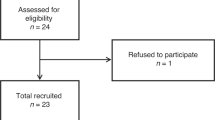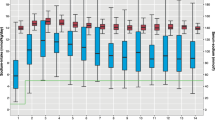Abstract
Objective:
To evaluate the relationship between enteral water infusion for hypernatremia and significant intestinal morbidity in infants ⩽1000 grams.
Study design:
This is a retrospective study of 321 infants ⩽1000 g birth weight. Infants were grouped by the highest serum sodium (mmol/l) during the first 14 days of life as follows: <150 (normal control), ⩾150 (high sodium control), ⩾150 and treated with sterile water (study group). Significant intestinal morbidity was defined as probable or proven necrotizing enterocolitis or spontaneous intestinal perforation. Statistical analysis included Student's t test for continuous variables and χ2 with Yeats correction for frequency variables. Multivariate logistic regression analysis was then performed to evaluate confounding variables among groups.
Results:
The incidence of intestinal morbidity was significantly higher in the high sodium-water treated group compared to each of the other groups (13/33 (38%) for high sodium-water versus 16/100 (16%) for high sodium control and 18/188 (10%) for normal sodium control, P<0.01 χ2). Logistic regression analysis indicated that enteral water and hydrocortisone were risk factors for significant intestinal morbidity.
Conclusions:
Enteral sterile water for hypernatremia appears to be associated with significant intestinal morbidity in infants ⩽1000 g. Hydrocortisone is also a risk factor.
This is a preview of subscription content, access via your institution
Access options
Subscribe to this journal
Receive 12 print issues and online access
$259.00 per year
only $21.58 per issue
Buy this article
- Purchase on Springer Link
- Instant access to full article PDF
Prices may be subject to local taxes which are calculated during checkout

Similar content being viewed by others
References
Blakely ML, Lally KP, McDonald S, Brown RL, Barnhart DC, Ricketts RR et al. Postoperative outcomes of extremely low birth-weight infants with necrotizing enterocolitis or isolated intestinal perforation. Ann Surg 2005; 241: 984–994.
Henry MC, Moss RL . Current issues in the management of necrotizing enterocolitis. Semin Perinatol 2004; 28: 221–233.
Caplan MS, MacKendrick W . Inflammatory mediators and intestinal injury. Clin Perinatol 1994; 21: 235–346.
Reber KM, Nankervis CA, Nowicki PT . Newborn intestinal circulation: physiology and pathophysiology. Clin Perinatol 2002; 29: 23–39.
Watterberg KL, Gerdes JS, Cole CH, Aucott SW, Thilo EH, Mammel MC et al. Prophylaxis of early adrenal insufficiency to prevent bronchopulmonay dysplasia: a multicenter trial. Pediatrics 2004; 114: 1649–1657.
Attridge JT, Clark R, Walker MW, Gordon P . New insights into spontaneous perforation using a national data set: (1) SIP is associated with early indomethacin. J Pernatol 2006; 26: 93–99.
Hwang H, Murphy JJ, Gow KW, Magee JF, Bekhit E, Jamieson D . Are localized intestinal perforations distinct from necrotizing enterocolitis? J Pediatr Surg 2003; 38: 763–767.
Schloerb PR, Wood JG, Casillan AJ, Tawfik O, Udobi K . Bowel necrosis caused by water in jejunal feeding. JPEN 2004; 28: 27–29.
Bell MJ, Ternberg JL, Feigin RD, Keating JP, Marshall R, Barton L et al. Necrotizing enterocolitis: therapeutic staging based upon clinical staging. Ann Surg 1978; 187: 1–7.
Fenton TR . A new growth chart for preterm babies: Babson and Benda's chart updated with recent data and a new format. BMC Pediatrics 2003; 3: 13 (available online at www.biomedcentral.com/1471-2431/3/13).
Richardson DK, Corcoran JD, Escobar GJ, Lee SK . SNAPP-II and SNAPPE-II: simplified newborn illness severity and mortality risk scores. J Pediatr 2001; 138: 92–100.
Kamlesh SM, Shareef MJ, Hocker JR, Clark SA, Ramiro SB, Drenckphol DC et al. Restricted fluid intake and outcome of neonates with birth weight 750–1500 g (published online April, 2005 at http://127.0.0.1:9080/PAS05/view.y?nu=PAS5L1_3350).
Hsu CH, Lee HC, Huang FY . Duplex ultrasonographic assessment of gut blood flow velocity: effect of meal composition in normal full-term newborns after first feed. J Ultrasound Med 1994; 13: 15–18.
Koenig WJ, Amarnath RP, Hench V, Berseth CL . Manometrics for preterm and term infants: a new tool for old questions. Pediatrics 1995; 95: 203–206.
Baker JH, Berseth CL . Duodenal motor responses in preterm infants fed formula with varying concentrations and rates of infusion. Pediatr Res 1997; 42: 618–622.
Dennis C . Injury to the ileal mucosa by contact with distilled water. Am J Physiol 1940; 129: 171–175.
Willis DM, Chabot J, Radde IC, Chance GW . Unsuspected hyperosmolality of oral solutions contributing to necrotizing enterocolitis in very-low-birth-weight infants. Pediatrics 1977; 60: 535–538.
Congdon PJ, Lloyd CA, Lindsay P, Cooke J . Unsuspected hyperosmolar oral solution contributing to necrotizing enterocolitis-a case report. J Clin Hosp Pharm 1982; 7: 127–130.
Book LS, Herbst JJ, Atherton SO, Jung AL . Necrotizing enterocolitis in low-birth-weight infants fed an elemental formula. J Pediatr 1975; 87: 602–605.
Norris HT . Response of the small intestine to the application of hypertonic solution. Am J Pathol 1973; 73: 747–760.
Nasrallah SM, Coburn WM, Iber FL . The effect of hypertonic mannitol on the intestine of man. Johns Hopkins Med J 1968; 123: 134–137.
Fordtran JS, Locklear TW . Ionic constituents and osmolality of gastric and small-intestinal fluids after eating. Am J Dig Dis 1966; 11: 503–521.
Billeaud C, Senterre J, Rigo J . Osmolality of the gastric and duodenal contents in low birth weight infants fed human milk or various formulae. Acta Paeditr Scand 1982; 71: 799–803.
Simmons MA, Adcock EW, Bard H, Battaglia FC . Hypernatremia and intracranial hemorrhage in neonates. N Engl J Med 1974; 291: 6–10.
Clarke AJ, Sibert JR . Hypernatremic dehydration and necrotizing enterocolitis. Postgrad Med J 1985; 61(711): 65–66.
Saeed MA . Severe hypernatremia in a very preterm infant. J Pak Med Assoc 1991; 41: 176–177.
Tyson JE, Kennedy KA . Trophic Feedings for Parenterally Fed Infants. (Cochrane Review). In: The Cochrane Library: Oxford; Update Software 2006.
Acknowledgements
We thank the physicians of Northwest Newborn Specialists PC and Kaiser Permenente of Oregon for allowing us to review medical records of their patients. We also acknowledge that the Vermont Oxford Data Base, of which both institutions are members, was most helpful in our review.
Author information
Authors and Affiliations
Corresponding author
Rights and permissions
About this article
Cite this article
Huston, R., Dietz, A., Campbell, B. et al. Enteral water for hypernatremia and intestinal morbidity in infants less than or equal to 1000 g birth weight. J Perinatol 27, 32–38 (2007). https://doi.org/10.1038/sj.jp.7211622
Received:
Revised:
Accepted:
Published:
Issue Date:
DOI: https://doi.org/10.1038/sj.jp.7211622



